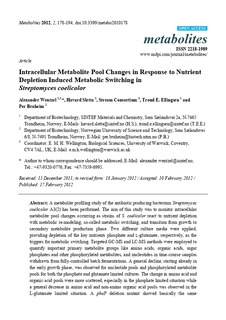| dc.contributor.author | Wentzel, Alexander | |
| dc.contributor.author | Sletta, Håvard | |
| dc.contributor.author | Wellington, E.M.H. | |
| dc.contributor.author | Ellingsen, Trond Erling | |
| dc.contributor.author | Bruheim, Per | |
| dc.date.accessioned | 2019-10-29T14:22:24Z | |
| dc.date.available | 2019-10-29T14:22:24Z | |
| dc.date.created | 2012-02-20T13:57:11Z | |
| dc.date.issued | 2012 | |
| dc.identifier.citation | Metabolites. 2012, 2 178-194. | nb_NO |
| dc.identifier.issn | 2218-1989 | |
| dc.identifier.uri | http://hdl.handle.net/11250/2625201 | |
| dc.description.abstract | A metabolite profiling study of the antibiotic producing bacterium Streptomyces coelicolor A3(2) has been performed. The aim of this study was to monitor intracellular metabolite pool changes occurring as strains of S. coelicolor react to nutrient depletion with metabolic re-modeling, so-called metabolic switching, and transition from growth to secondary metabolite production phase. Two different culture media were applied, providing depletion of the key nutrients phosphate and L-glutamate, respectively, as the triggers for metabolic switching. Targeted GC-MS and LC-MS methods were employed to quantify important primary metabolite groups like amino acids, organic acids, sugar phosphates and other phosphorylated metabolites, and nucleotides in time-course samples withdrawn from fully-controlled batch fermentations. A general decline, starting already in the early growth phase, was observed for nucleotide pools and phosphorylated metabolite pools for both the phosphate and glutamate limited cultures. The change in amino acid and organic acid pools were more scattered, especially in the phosphate limited situation while a general decrease in amino acid and non-amino organic acid pools was observed in the L-glutamate limited situation. A phoP deletion mutant showed basically the same metabolite pool changes as the wild-type strain M145 when cultivated on phosphate limited medium. This implies that the inactivation of the phoP gene has only little effect on the detected metabolite levels in the cell. The energy charge was found to be relatively constant during growth, transition and secondary metabolite production phase. The results of this study and the employed targeted metabolite profiling methodology are directly relevant for the evaluation of precursor metabolite and energy supply for both natural and heterologous production of secondary metabolites in S. coelicolor. | nb_NO |
| dc.language.iso | eng | nb_NO |
| dc.publisher | MDPI | nb_NO |
| dc.rights | Navngivelse 4.0 Internasjonal | * |
| dc.rights.uri | http://creativecommons.org/licenses/by/4.0/deed.no | * |
| dc.title | Intracellular metabolite pool changes in response to nutrient depletion induced metabolic switching in Streptomyces coelicolor | nb_NO |
| dc.type | Journal article | nb_NO |
| dc.type | Peer reviewed | nb_NO |
| dc.description.version | publishedVersion | nb_NO |
| dc.rights.holder | © 2012 by the authors; licensee MDPI, Basel, Switzerland. This article is an open access article distributed under the terms and conditions of the Creative Commons Attribution license (http://creativecommons.org/licenses/by/3.0/). | nb_NO |
| dc.source.pagenumber | 178-194 | nb_NO |
| dc.source.volume | 2 | nb_NO |
| dc.source.journal | Metabolites | nb_NO |
| dc.identifier.doi | 10.3390/metabo2010178 | |
| dc.identifier.cristin | 910705 | |
| cristin.unitcode | 7401,80,1,0 | |
| cristin.unitname | Bioteknologi og nanomedisin | |
| cristin.ispublished | true | |
| cristin.fulltext | original | |
| cristin.qualitycode | 1 | |

